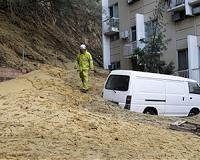| . |  |
. |
Rampur, India (AFP) April 15, 2010 Indian authorities battled blocked roads and downed power lines on Thursday as they rushed aid to victims of a storm that has left hundreds of thousands homeless and killed 116 people. In West Bengal state, 250,000 people lost their homes when the tropical storm, with winds of more than 120 kilometres (75 miles) an hour, ravaged isolated areas of northeast India and Bangladesh overnight Tuesday. "Rescuers are racing against time to reach the displaced people, but roads blocked with uprooted trees have delayed their movements," said West Bengal minister of state for civil defence, Srikumar Mukherjee. He said the storm had killed thousands of cattle and ruined summer crops in the North Dinajpur district. Officials in the affected states of West Bengal, Bihar and Assam said a total of 114 people had been killed. Two others were reported dead in Bangladesh, including a police officer. In Rampur village, 200 miles (320 kilometres) north of state capital Kolkata, the roofs of every house had collapsed or been blown away. Hundreds of stranded people were taking shelter in school and temple premises. A local television journalist in the area, Soma Chakraborty, told AFP that thousands of people had surrounded government offices and schools, shouting in frustration at the slow rescue and relief operation. "Food, shelter and medical care are in short supply in the overcrowded relief camps set up in school buildings," she said. A resident of Raigunj, one of the affected areas in West Bengal, Ira Dev, told AFP that the first aid to reach her village arrived on Thursday morning. "I am starving with my four children," said the 35-year-old wife of a rickshaw puller. Local hospitals were overwhelmed. The chief medical officer of Raigunj district hospital, Arabinda Tantrik, told AFP that several hundred people had come with storm-related injuries, with 35 critically injured patients admitted. "We have asked for more medicines from the authorities. We have also heard that many injured could not be brought to the hospital due to the lack of transport," he said. In Bihar, the worst-affected state, chief minister Nitish Kumar returned from an aerial tour of the disaster area on Wednesday to say damage was more extensive than initially thought. Seventy-two people had died and an estimated 40,000 homes were destroyed in Purnia, Araria and Kishanganj districts, the state disaster management office told AFP. "We are trying to provide relief to all victims," Purnia district magistrate N. Sarvan Kumar told AFP on Thursday. "Thousands of hamlets made up of thatched and thin steel sheet, have been blown away. Mud huts and small houses were completely destroyed." In Bihar, the families of those killed have been offered compensation of 150,000 rupees (2,400 dollars). There were 38 storm deaths in West Bengal, while four people perished and 500 homes were lost in the northern state of Assam, and 12,000 homes were damaged in Bangladesh, officials said told AFP. The cyclone came amid unseasonably high temperatures across much of northern India, where the mercury is already above 40 degrees Celsius (104 degrees Fahrenheit) in many areas. Local news agencies have reported 43 heat-related deaths, mostly in the eastern state of Orissa. One person was reported to have died in the western state of Gujarat. The weather department on Tuesday said nine of India's 29 states were sizzling in a heatwave. burs-adp/pdw
Share This Article With Planet Earth
Related Links Weather News at TerraDaily.com
 Chaos as freak storm batters Australia's Perth
Chaos as freak storm batters Australia's PerthPerth (AFP) March 23, 2010 Some 100,000 people were left without power Tuesday after a freak storm battered the Australian city of Perth, hurling golf ball-sized hailstones and causing floods and landslides. Western Australia premier Colin Barnett estimated a damage bill of hundreds of millions of dollars after the wild weather smashed into the city late on Monday, paralysing flights and commuter traffic. Thousand ... read more |
|
| The content herein, unless otherwise known to be public domain, are Copyright 1995-2010 - SpaceDaily. AFP and UPI Wire Stories are copyright Agence France-Presse and United Press International. ESA Portal Reports are copyright European Space Agency. All NASA sourced material is public domain. Additional copyrights may apply in whole or part to other bona fide parties. Advertising does not imply endorsement,agreement or approval of any opinions, statements or information provided by SpaceDaily on any Web page published or hosted by SpaceDaily. Privacy Statement |